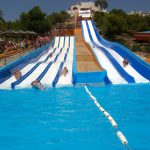Last updated on September 13th, 2019 at 09:10 am.
Keeping safe in the water is a particularly important issue around this time of year. Last July and August 155 people drowned in Spain. Of course, there are a number of self evident measures you can take that could be considered common sense.
Making sure children can swim and know basic water safety is vital. You can’t be with them all of the time as they grow up and they do not have the same level of hesitation when it comes to jumping the waves.
You should also familiarise yourself with what the different flags mean when they are on display and some of the hazards you might encounter when swimming in the sea.
Flag colours
A red flag means that you should not swim and if a yellow flag is flying you should take great care:
Green flag = safe bathing conditions
Yellow flag = bathing with caution
Red flag = no bathing
Do take note of the flags and follow the instructions of the lifeguard. It’s surprising every year how many people don’t.
Rip currents
A rip current is a body of water moving out to sea. You can recognise it by seeing calm patches of sea with breaking waves on either side. There might be foamy water with debris and the water might be discoloured because sand is stirred up within it.
If you do find yourself pulled along by one, don’t try and swim against it. Instead you should swim to the side towards where the waves are breaking.
Jelly fish
Jelly fish may look harmless but they carry toxins in their tentacles which are used for hunting and defence. If stung, in most cases you will just suffer minor discomfort although some stings are more dangerous and should be treated immediately.
Jellyfish tend to come together in what are called ‘blooms’ and it is thought that overfishing and the resulting decline in natural predators such as tuna is partly responsible for the apparent increase.
If there is a sudden invasion you might find that the red flag is displayed. It’s for your safety to stay out of the water at this time. If you are stung by a jellyfish you may develop an itchy rash and you should seek medical attention. In the meantime bathing the sting with vinegar or sea water can help. You should avoid rubbing the area where you were stung and should not try to remove a tentacle.
Enjoy the sea
In the end, it’s wise to be wary but you shouldn’t be put off visiting the beach. The vast majority of people enjoy the sea and the sand in Spain with no problem at all. A little bit of caution and you and your family can enjoy its enviable stretches of glorious sand and cool down in its blue seas without fear.
Our safety tips
At the seaside
- familiarise yourself with the idiosyncrasies of the beaches in your local area. Are they renowned for a sharp drop from a shelf into deeper water? Are there strong currents there? Is a lifeguard on duty and when?
- it is safest to always enter the water with someone else – they can raise the alarm if you get into trouble or suddenly feel ill
- be aware that jumping into cold water out of the heat of the sun might feel good but it can also give a shock to the body – enter the water slowly
- warm up before you swim
- if you are an elderly swimmer have a periodic check to make sure you are fit and healthy for swimming in the sea
- know your swimming ability and be clear what the acceptable boundaries and swimming distance are – identify a landmark that you will not swim beyond
- do not rely on swimming aids – consider what would happen if you lost your float at that depth
- do not swim immediately after a meal
- pay attention to the flags and lifeguards – they are there for your safety
- don’t swim in the dark or when vision is impeded, for whatever reason
By the pool
- never leave small children unsupervised by water – no matter how shallow it might be
- stay within ‘touch supervision’ – an adult swimmer should be within arm’s reach of infants, toddlers and weak swimmers
- make sure that any shallow areas of a swimming pool are clearly marked to avoid diving accidents
- be wary of the dangers of slipping and falling into the pool – aim to reduce slippery surfaces around the pool and obstacles that might cause people to trip
- keep floats handy, either in the water or at the side of the pool, where they can be accessed quickly
- don’t assume because a child can swim that they can be left unsupervised in a swimming pool
- a pool should be fenced with a locked gate for when it is not in use
- make sure your pool and security, like fences and gates, are well-maintained and in good working order
- don’t leave climbable objects close to boundary fences and gates
- older children should not be left to supervise younger children by the pool
No comments yet
There are no comments on this post yet.




Leave a comment